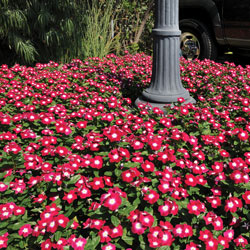1/26/2011
Vinca: The Story of One Tough, Hot Annual
Mark Elzinga

Usually when I’m asked to write an article, I generally enjoy the challenge. However, when I found out it involved the popular annual vinca, I knew I was going to have to do a little more research than usual.
I’ll admit that growing vinca in the Midwest is tough, but that’s why I have one of the best growers in the Midwest (Roger Rosenthal) on my payroll.
“So Roger,” I said, “I need you to help me write an article on vinca.” “Yeah, like that’s going to happen,” he replied. “There’s a reason we contract it out. To do it right and to do it well, you need lots of heat.”
“It can’t be that hard,” I say. “Will and Mel grow vinca at our other location.” Roger’s quick response was to have “Will and Mel” write my article.
So I seek out Melanie Olech and say to her “So, Mel, I need you to help me write an article on vinca.”
“No way,” she says. “Vinca needs lots of heat, the pH has to be a perfect 5.5-6.0 all the time, and I’m sure not expert enough to write an article.”
Mumbling frustrated thoughts, I decided to ask William Scholten. He never lets me down and he loves a challenge.
“So, Will,” I say, “I need you to help me write an article on vinca.”
With wide eyes, he says, “Mark, don’t you think Roger and Mel could do a better job for you? You really need acidic soil, and you always have to worry about botrytis. We’ve had some good luck with Metro Mix, but it needs so much heat! I’m just not qualified.” Starting to get a little worried now, I knew I’d have to grovel to Roger again.
“Geesh, Mark,” Roger says, clearly irritated with me, “Vinca’s watering needs are different. You need to water early, let the leaves dry off and worry constantly about botrytis. A good preventive spray program is a must. It also needs high light, especially here in Michigan. But, if you really want to know how to grow a good vinca crop, call someone in Florida.”
I walked away starting to wonder if I made a mistake taking on this assignment. Okay … I’ve got to ask Mel one more time.
“Mark, here’s what I know,” she says. “We buy plugs in 288 and 512 trays. I know that our plug grower keeps the plugs at stage 1 wet (level 4), and after we transplant them we try to maintain an even moisture level, actually to the dry side. Heat is important with a minimum of 70F (21C) at night and 75F (24C) during the day. We use DIFF for height control instead of PGRs, but that’s just us. Some growers may need PGRs. But I’m just not comfortable telling others how to grow vinca.”
Boy, my deadline is almost here and I’m getting nowhere. Maybe I should tell them that I can’t do it, but I just know that Will has more information than he’s telling me.
“William,” I said, “You’re one of the best growers I’ve got, but I need more information from you before I can finish my article.”
“Ok”, he says, “here’s what I know. I don’t like to grow vinca because we don’t have enough bench space with heat above and heat below unless you want to buy infrared heaters. I hear they work really well.” (Great, I’m thinking … somebody’s always trying to spend my money).
“Also keep these in mind,” Will continued:
- They need lots of heat—70F (21C) nights, 75F (24C) days.
- A preventative disease plan is a must for botrytis and for rhizoctonia.
- Don’t leave the leaves too wet.
- For fertilizer, we use a constant rate of 200 ppm and an EC of 1.5-2.0.
- pH should remain a constant level of 5.5-6.0.
- In the Midwest, a grower should ask a premium on growing it exclusively as a specialty crop.
- Growers in the southern states just plain have an advantage because of the heat.
“There, I’ve told you everything, but it still doesn’t make growing it any easier,” he finished.
Well, there you have it, readers. Vinca is a tough crop to grow here in the Midwest unless all the right factors are in place. I do know one thing, though. Every year vinca grows in popularity and I really need to figure out a better way for my business to grow it so I can cash in on that trend.
GT
Mark Elzinga is president of Elzinga & Hoeksema Greenhouses, one of southwest Michigan’s largest commercial greenhouse growers of annuals, baskets, mixed containers and organic edibles for Midwestern garden centers and regional store chains.